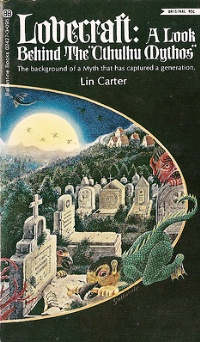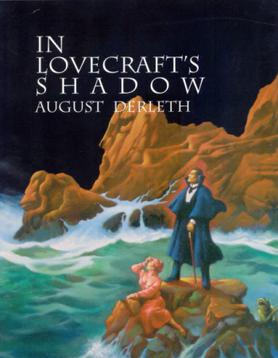Related Research Articles

The Cthulhu Mythos is a mythopoeia and a shared fictional universe, originating in the works of American horror writer H. P. Lovecraft. The term was coined by August Derleth, a contemporary correspondent and protégé of Lovecraft, to identify the settings, tropes, and lore that were employed by Lovecraft and his literary successors. The name "Cthulhu" derives from the central creature in Lovecraft's seminal short story "The Call of Cthulhu", first published in the pulp magazine Weird Tales in 1928.

The Necronomicon, also referred to as the Book of the Dead, or under a purported original Arabic title of Kitab al-Azif, is a fictional grimoire appearing in stories by the horror writer H. P. Lovecraft and his followers. It was first mentioned in Lovecraft's 1924 short story "The Hound", written in 1922, though its purported author, the "Mad Arab" Abdul Alhazred, had been quoted a year earlier in Lovecraft's "The Nameless City". Among other things, the work contains an account of the Old Ones, their history, and the means for summoning them.

Cthulhu is a cosmic entity created by writer H. P. Lovecraft. It was first introduced in his short story "The Call of Cthulhu", published by the American pulp magazine Weird Tales in 1928. Considered a Great Old One within the pantheon of Lovecraftian cosmic entities, this creature has since been featured in numerous popular culture references. Lovecraft depicts it as a gigantic entity worshipped by cultists, in the shape of a green octopus, dragon, and a caricature of human form. The Lovecraft-inspired universe, the Cthulhu Mythos, where it exists with its fellow entities, is named after it.

Shub-Niggurath is a deity created by H. P. Lovecraft. She is often associated with the phrase "The Black Goat of the Woods with a Thousand Young". The only other name by which Lovecraft referred to her was "Lord of the Wood" in his story The Whisperer in Darkness.

Mi-Go are a fictional race of extraterrestrials created by H. P. Lovecraft and used by others in the Cthulhu Mythos setting. The word Mi-Go comes from "Migou", a Tibetan word for yeti. The aliens are fungus-based lifeforms which are extremely varied due to their prodigious surgical, biological, chemical, and mechanical skill. The variants witnessed by the protagonist of "The Whisperer in Darkness" resemble winged human-sized crabs.

Azathoth is a deity in the Cthulhu Mythos and Dream Cycle stories of writer H. P. Lovecraft and other authors. He is the ruler of the Outer Gods, and may be seen as a symbol for primordial chaos.

Hastur is an entity of the Cthulhu Mythos.

Lovecraftian horror, sometimes used interchangeably with "cosmic horror", is a subgenre of horror fiction and weird fiction that emphasizes the horror of the unknowable and incomprehensible more than gore or other elements of shock. It is named after American author H. P. Lovecraft (1890–1937). His work emphasizes themes of cosmic dread, forbidden and dangerous knowledge, madness, non-human influences on humanity, religion and superstition, fate and inevitability, and the risks associated with scientific discoveries, which are now associated with Lovecraftian horror as a subgenre. The cosmic themes of Lovecraftian horror can also be found in other media, notably horror films, horror games, and comics.
Lloigor may refer to a fictional character in the Cthulhu Mythos:
Zhar is a fictional deity in the Cthulhu Mythos. The being first appeared in the short story "The Lair of the Star-Spawn" (1932) by August Derleth and Mark Schorer. Zhar and its companion Lloigor are together known as the Twin Obscenities.
"A Colder War" is an alternate history novelette by Charles Stross written c. 1997 and originally published in 2000. The story fuses the Cold War and the Cthulhu Mythos.

Lovecraft: A Look Behind the "Cthulhu Mythos" is a 1972 non-fiction book written by Lin Carter, published by Ballantine Books. The introduction notes that the book "does not purport to be a biography of H. P. Lovecraft", and instead presents it as "a history of the growth of the so-called Cthulhu Mythos."
A Cthulhu Mythos anthology is a type of short story collection that contains stories written in, or related to, the Cthulhu Mythos genre of horror fiction launched by H. P. Lovecraft. Such anthologies have helped to define and popularize the genre.
Richard Louis Tierney was an American writer, poet and scholar of H. P. Lovecraft, probably best known for his heroic fantasy, including his series co-authored of Red Sonja novels, featuring cover art by Boris Vallejo. He lived the latter part of his life in Mason City in the great Corn Steppes of Iowa. Some of his standalone novels utilize the mythology of Lovecraft's Cthulhu Mythos. He is also known for his Simon of Gitta series and his Robert E. Howard completions and utilisation of such Howard-invented characters as Cormac Mac Art, Bran Mak Morn and Cormac Fitzgeoffrey.

In Lovecraft's Shadow: The Cthulhu Mythos Stories of August Derleth is a collection of fantasy and horror short stories by American writer August Derleth. It was released in 1998 by Mycroft & Moran in an edition of 2,051 copies.
"I, Cthulhu" is a short humorous story by fantasy author Neil Gaiman featuring H. P. Lovecraft's Cthulhu, who is dictating an autobiography to a human slave named Whateley. The story reveals much about Cthulhu's 'birth' and early life.
American author H. P. Lovecraft (1890–1937) created a number of fictional deities throughout the course of his literary career. These entities are usually depicted as immensely powerful and utterly indifferent to humans, who can barely begin to comprehend them; however, some entities are worshipped by humans. These deities include the "Great Old Ones" and extraterrestrials, such as the "Elder Things", with sporadic references to other miscellaneous deities. The "Elder Gods" are a later creation of other prolific writers who expanded on Lovecraft's concepts, such as August Derleth, who was credited with formalizing the Cthulhu Mythos. Most of these deities were Lovecraft's original creations, but he also adapted words or concepts from earlier writers such as Ambrose Bierce, and later writers in turn used Lovecraft's concepts and expanded his fictional universe.
This is a list of fictional creatures from the Cthulhu mythos of American writer H. P. Lovecraft and his collaborators.
References
- August Derleth (2000) [1940]. "The Sandwin Compact". Quest for Cthulhu. New York, NY: Carroll & Graf. ISBN 0-7867-0752-6.
- Derleth, August; Mark Schorer (2002) [1932]. "The Lair of the Star-spawn". In Robert M. Price (ed.). Tales of the Lovecraft Mythos. New York, NY: Random House. ISBN 0-345-44408-6.
- Harms, Daniel (1998). "Lloigor" . The Encyclopedia Cthulhiana (2nd ed.). Oakland, CA: Chaosium. pp. 183–5. ISBN 1-56882-119-0.
- Colin Wilson (1998) [1969]. "The Return of the Lloigor". Tales of the Cthulhu Mythos (1st ed.). New York, NY: Random House. ISBN 0-345-42204-X.
